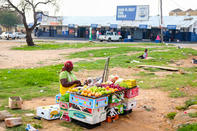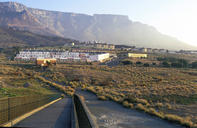The Harsh Reality
Consider what it’s like for all time- and cash- strapped parents who have to return home each night and make sure their children go to bed on a filling meal.

Where in that long day must they find the time to buy the groceries, haul them home and then prepare the main meal of the day? This is one reason why many people might choose food that’s fast and easy to prepare, which might be highly processed just to fill the belly and drive out hunger, but not feed the body with the nutrients it needs.
This is the reality for many people living in South Africa’s cities, which still echo with the imprint of the apartheid state’s segregationist planning that separated white, from coloured, from black.
Cape Town is no different, and this notion of separate development is what turned the Cape Flats into what was once called the ‘dumping ground’ for black and coloured people in the city. The racist policy pushed the artisan and working classes out onto the edges of the city, creating enclaves of poverty that still exist today.
This means poorer people have to travel greater distances to get to and from work, something that costs them enormously in both time and money.
Economics professor with the University of Cape Town’s (UCT) Environmental Policy Research Unit (EPRU), Anthony Black reminds us that the apartheid-era design of our cities means that finding employment and commuting to work is difficult and costly for poorer people, and effectively constitute a tax on the poor and become a barrier to employment.
Urban Influence

The city makes us fat and sick. The rising rates of obesity in South Africa mirror similar trends around the world. In the past, the medical community blamed the individual for eating badly and not exercising. But there has been a sea change in attitude regarding this. The medical journal, The Lancet, in its special report on obesity in 2011, says rising obesity is the normal response of normal people to an abnormal environment.
What is it about the modern urban world that creates this ‘obesogenic’ environment? It has to do with:
The sprawling layout of the city that pushes us into automated transport and discourages walking and cycling. Also, work and recreation are often sedentary with machines doing most of the ‘heavy lifting’ these days.
The kind of food available is often cheap, highly processed and energy dense, and is high in sugar and refined carbohydrates.
Cultural attitudes towards foods often encourage us to buy ‘sophisticated’ branded foods, which enables the ‘nutritional transition’ to the Western industrialised diet.
Our dependence on these foods, which is being seen as addictive behaviour.
To fix the problem, we need to look at the way the city, our food and its inhabitants relate to one another. That’s not to say that the individual isn’t responsible for his or her lifestyle and food choices, but as the UK’s House of Lords report on rising obesity in Britain put it, the modern urban life makes it too hard to make the right food and lifestyle choices, and too easy to make the wrong ones.
If we only focus on individual behaviour as the root of the epidemic, we’ll only focus on education and encouraging personal behaviour change as the solution, and it is unlikely to have much success. There isn’t a quick fix and we need to take a more sophisticated view of things, particularly as people continue to move to the city. Right now, 60% of South Africans live in cities and this is likely to increase considerably in the future.